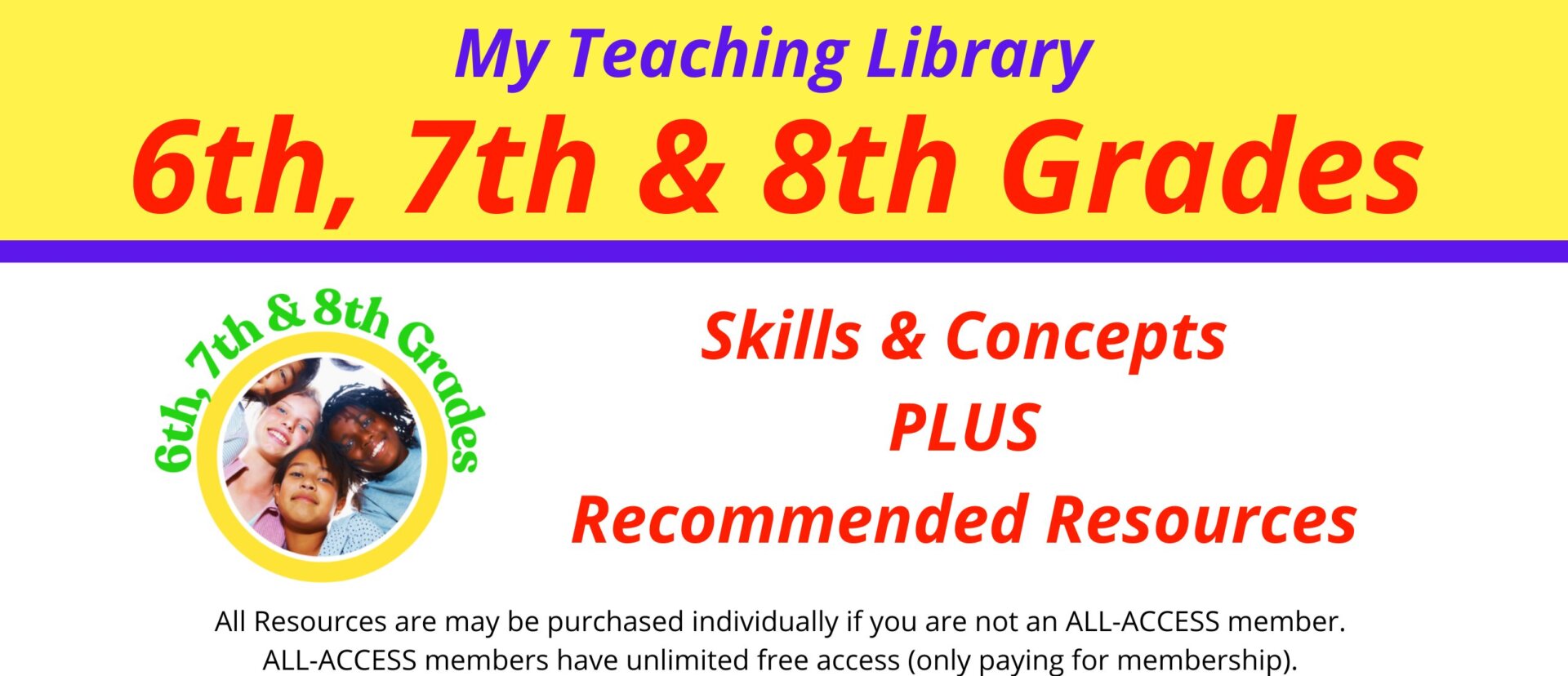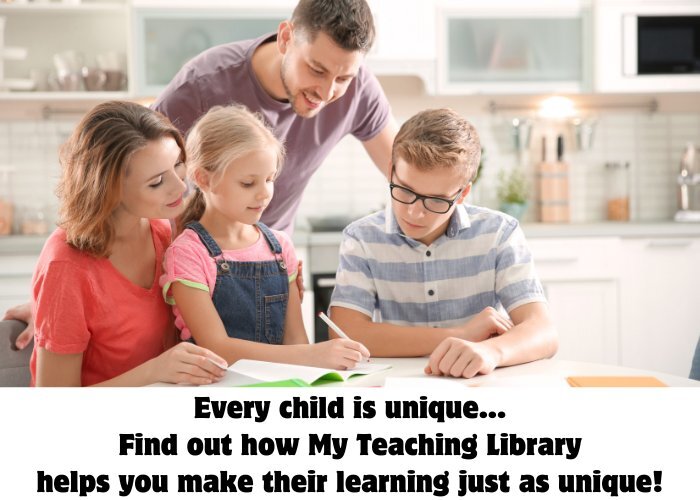Language Arts | Reading, Grammar, Writing, Speaking |
||||
| 6th Grade | ||||
|
||||
|
Curriculum Top Picks:
(All resources are FREE to ALL-ACCESS members | Non-Members pay listed prices)
Great Text from the Past
McGuffeys Sixth Eclectic Reader
6th Grade
Language Arts 1 | Student Edition
Language Arts 1 | Teacher’s Guide
Daily Vocabulary for Middle School
Latin Word Roots | Reference
Advanced Novel Study | Holes
Generic Novel Study Unit Activities | Reading Comprehension
Pride and Prejudice Novel Study
Research Paper | Topic Selection and Thesis Statement Guide
Layered Research Assignment
Women in U.S. History – 15 Projects | Research – Writing – Presentation
7th Grade
Language Arts 2 | Student Edition
Language Arts 2 | Teacher’s Guide
Daily Vocabulary for Middle School (If not completed in 6th grade)
Latin Word Roots | Reference
Daily Grammar for Middle School
Generic Novel Study Unit Activities | Reading Comprehension
The Hobbit – Novel Study
Research Paper | Topic Selection and Thesis Statement Guide
Layered Research Assignment
Women in U.S. History – 15 Projects | Research – Writing – Presentation
8th Grade
Language Arts 3 | Student Edition
Language Arts 3 | Teacher’s Guide
Latin Word Roots | Reference
Daily Grammar for Middle School (If not completed in the 7th grade)
Generic Novel Study Unit Activities | Reading Comprehension
Pride and Prejudice Novel Study
Research Paper | Topic Selection and Thesis Statement Guide
Layered Research Assignment
Women in U.S. History – 15 Projects | Research – Writing – Presentation
Famous African Americans – 10 Projects | Research – Writing – Presentation
Additional Resources for Advanced Students:
Poems Teachers Ask For – Volume 1
Poems Teachers Ask For – Volume 2
Literature By Author
Search ALL AVAILABLE Resources for 6th, 7th & 8th Grades here.
Math |
||||||||||
| General Concepts & Skills | ||||||||||
| (Grade 6) a. Divides fractions by fractions. b. Solves equations using ratios and rates or percentages. c. Solves equations with negative numbers. d. Multiplies and divides multi-digit numbers. e. Finds common factors and multiples. f. Understands and talk about ratios using mathematical language. For example, the ratio of girls to boys in the class is 2:3. g. Solves algebraic equations with one variable and explains how these equations were solved. h. Solves geometry equations related to surface area, area, and volume as applied to real-world situations. i. Develops skills in statistical analysis and applies statistical concepts, including mean, median, variability, and range. j. Analyzes mathematical data, thinking about how data was collected and looking at patterns in the data, including clusters, peaks, gaps, and symmetry. k. Explains the process used and thinking behind how problems and equations are solved. (Grade 7) (Grade 8) |
||||||||||
|
Curriculum Top Picks:
(All resources are FREE to ALL-ACCESS members | Non-Members pay listed prices)
6th Grade
Mathematics I | Middle School – Student Edition
Mathematics I | Middle School – Teacher Edition
Plus:
Daily Math Skills Review | Middle School Edition Volume 1
Daily Math Skills Review | Middle School Edition Volume 2
For more advanced students:
Mathematics 2 | Middle School – Student Edition
Mathematics 2 | Middle School – Teacher Edition
7th Grade
Mathematics 2 | Middle School – Student Edition
Mathematics 2 | Middle School – Teacher Edition
Plus:
Daily Math Skills Review | Middle School Edition Volume 1 (If not completed in the 6th grade)
Daily Math Skills Review | Middle School Edition Volume 2 (If not completed in the 6th grade)
For more advanced students:
Mathematics 3 | Middle School – Student Edition
Mathematics 3 | Middle School – Teacher Edition
or if ready…
Pre-Algebra | Middle School – Student Edition
Pre-Algebra | Middle School – Teacher Edition
8th Grade
Mathematics 3 | Middle School – Student Edition
Mathematics 3 | Middle School – Teacher Edition
(or)
Pre-Algebra | Middle School – Student Edition
Pre-Algebra | Middle School – Teacher Edition
For highly advanced students (if Pre-Algebra has already been completed)
Algebra 1 | Student Edition
Algebra 1 | Teacher Edition
Search ALL AVAILABLE Resources for 6th, 7th & 8th Grades here.
Science |
||||||||
| General Concepts & Skills | ||||||||
|
– Plans and conducts investigations and experiments. |
||||||||
|
Curriculum Top Picks:
(All resources are FREE to ALL-ACCESS members | Non-Members pay listed prices)
Natural Science: Physics & Earth Science – Grade 7 (Student Edition)
Natural Science: Physics & Earth Science – Grade 7 (Teacher’s Edition)
Natural Science: Biology & Chemistry – Grade 7 (Student Edition)
Natural Science: Biology & Chemistry – Grade 7 (Teacher’s Edition)
Natural Science: Physics & Earth Science – Grade 8 (Student Edition)
Natural Science: Physics & Earth Science – Grade 8 (Teacher’s Edition)
Natural Science: Biology & Chemistry – Grade 8 (Student Edition)
Natural Science: Biology & Chemistry – Grade 8 (Teacher’s Edition)
Science Lab Report Worksheet and Rubric
Search ALL AVAILABLE Resources for 6th, 7th & 8th Grades here.
Social Studies |
||||||||||||||||||||||||||||||||||
| General Concepts & Skills | ||||||||||||||||||||||||||||||||||
| (By the end of Grade 8) – Use critical reasoning skills to analyse and evaluate claims: a. Analyze positions and evidence supporting an issue or an event. b. Evaluate the logic of reasons for a position on an issue or event. – Use inquiry-based research: – Deliberates public issues: – Creates a product that uses social studies content to support a thesis and presents the product in an appropriate manner to a meaningful audience: |
||||||||||||||||||||||||||||||||||
|
Curriculum Top Picks:
(All resources are FREE to ALL-ACCESS members | Non-Members pay listed prices)
Geography:
Regions of the U.S.A. | Geography Bundle (If not covered in 4th-5th grades) Includes the following:
– Regions of the U.S. – Northeast Region | Informational Text and Worksheet
– US Geography – Northeast Scrapbooking Pages
– Regions of the U.S. – Midwest Region – Informational Text and Worksheets
– US Geography – Midwest Scrapbooking Pages
– Regions of the U.S. – South Region – Informational Text and Worksheets
– US Geography – South Scrapbooking Pages
– Regions of the U.S. – West Region – Informational Text and Worksheets
– US Geography – West Scrapbooking Pages
– US States – Nomenclature Cards
5 Themes of Geography BUNDLE
5 Themes of Geography Full-Year Notebooking Bundle | North and South America
Geography Notebooking | Western Europe Bundle
American History:
American History 1 | Teacher’s Guide
American History 1 | Student
Civil War Curriculum
Women in U.S. History – 15 Projects | Research – Writing – Presentation
Famous African Americans – 10 Projects | Research – Writing – Presentation
World History:
World History 1 | Student
World History 1 | Teacher’s Guide
Economics:
Economics | Student Edition
Economics – Teacher’s Guide
World History 1 | Teacher’s Guide
Civics:
U.S. Elections: A Student-Centered Project-Based Unit for 4th-6th Grades
Candidate Analysis – Comparing Candidates Election Activity
U.S. Elections | 3 Informational Articles and Worksheets

